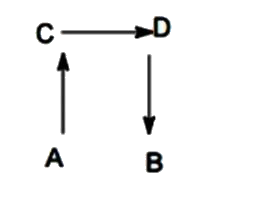The reaction A to b is not feasible but on changing entropy through a series of steps:

ΔS(A→C)=50ev,
ΔS(C→D)=30ev,
ΔS(B→D)=20ev.
The entropy change for A→B would be
100eV
60eV
−60eV
−100eV
The correct Answer is:B
ΔS(A→B)=ΔS(A→C)+ΔS(C→D)+ΔS(D→B)
=ΔS(A→C)+ΔS(C→D)−ΔS(B→D)
=50+30−(20)=60eV.
Topper's Solved these Questions
- THERMODYNAMICSBOOK - MODERN PUBLICATIONCHAPTER - THERMODYNAMICSEXERCISE - Competition File (Matching Type Questions)
2 Videos
- THERMODYNAMICSBOOK - MODERN PUBLICATIONCHAPTER - THERMODYNAMICSEXERCISE - Competition File (Matrix Matching Type Questions)
4 Videos
- THERMODYNAMICSBOOK - MODERN PUBLICATIONCHAPTER - THERMODYNAMICSEXERCISE - Higher Order Thinking Questions
16 Videos
- STRUCTURE OF ATOMBOOK - MODERN PUBLICATIONCHAPTER - STRUCTURE OF ATOMEXERCISE - Unit Practice Test
13 Videos
Similar Questions
The direct conversion of A or B is difficult, hence it is carried out by the following shown path
Given, ΔSA→C=50eu, ΔSC→D=30eu,ΔSB→D=20eu

Where eu is entropy unit, then ΔSA→B is .
View SolutionThe direct conversion of A or B is difficult, hence it is carried out by the following shown path
Given, ΔSA→C=50eu, ΔSC→D=30eu,ΔSB→D=20eu

Where eu is entropy unit, then ΔSA→B is .
View Solution
Knowledge Check
The direct conversion of A to B is difficult, hence, it is carried out by the following path:

Given:
ΔSA→C=50 c.u,
ΔSC→D=30 c.u.
ΔSB→D=20 c.u where e.u is the entropy unit.
Then, ΔSA→B is:A+60 euB+100 e.uC−60 e.uD100 e.uThe direct conversion of A to B is difficult, hence is carried out by the following shown path:
Δ(A→C)=50,ΔS(C→D)=30,ΔS(B→D)=20 The entropy change for the process A→B is :A100B−60C−100D+60Which reaction has the greatest positive change in entropy, ΔS?
A2Mg(s)+O2(g)→2MgO(s)B2C2H2(g)+5O2(g)→4CO2(g)+2H2O(l)C2KClO3(s)→2KCl(s)+3O2(g)D2SO2(g)+O2(g)→2SO3(g)
The direct conversion of A to B is difficult, hence it is carried out as
A→C→D→B
Given, ΔS(A→C)=50eU,ΔS(C→D)=30eU,ΔS(B→D)=20eU, where eU is entropy unit. Thus the change in entropy in (A→B) is:
View SolutionThe direct conversion of A to B is difficult, hence it is carried out as
A→C→D→B
Given, ΔS(A→C)=50eU,ΔS(C→D)=30eU,ΔS(B→D)=20eU, where eU is entropy unit. Thus the change in entropy in (A→B) is:
View SolutionA process A→B is difficult to occur directly instead it takes place in the three successive steps.
ΔS(A→C)=50e.u.
ΔS(C→D)=30e.u.
ΔS(B→D)=20e.u. where e.u. is entropy unit. Then the entropy change for the process ΔS(A→B) is:
View SolutionThe direct conversion of A to B is difficult. Hence it is carried out by the following shown path:
ΔS(A→C)=50e.u.,ΔS(C→D)=30e.u,
ΔS(B→D)=20e.u where e.u is entropy unit.
Then ΔS(A→B),
View SolutionThe direct conversion of A to B is difficult, hence it is carried out as
A→C→D→B
Given, ΔS(A→C)=50eU,ΔS(C→D)=30eU,ΔS(B→D)=20eU, where eU is entropy unit. Thus the change in entropy in (A→B) is:
View Solution
